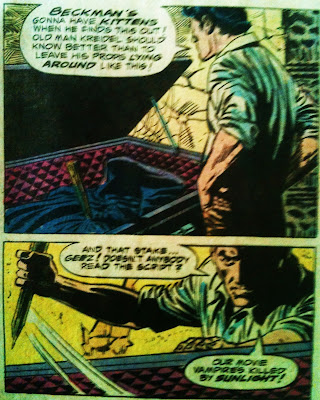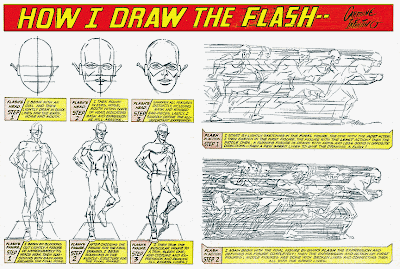Once upon a time, it was a fairly common practice not to reveal a character's origin in his first issue. Nowadays, it's apparently a requirement for comic books to tell the hero's origin story in his first appearance, usually making the origin the main point of the tale. I kind of like it when there's a little mystery. But then again, I enjoy reading the frequently denigrated Atlas/Seaboard line of comics from the 1970s, so what do I know?
Anyway, picking up from where I left off last time, our overlooked and underrated hero The Cougar lasted a mere two issues before the plug was pulled. As you well know, I quite liked The Cougar #1. I found the title character to be a refreshing change of pace from the usual super hero fare. Can The Cougar #2 measure up? Will it be found wanting? Will it outstrip the excellent first issue? Let's find out!
Cougar versus Wolf!
Beginning, as comic books usually do, with the cover, everything looks to be at least on par with The Cougar #1. Take a gander at that cover! They just don't make dynamic covers like this anymore. The Cougar is
fearlessly leaping down to tackle a werewolf who clings to the theater's
curtain even as he shreds our hero's back with his claws. Nowadays everything is static: a hero or group of heroes standing around as though posing for a sepia-toned photograph. Yuck.
The Cougar #2 was written by Gary Friedrich, who had done some work at Marvel, and drawn by the illustrious Frank Springer, who also contributed to the first issue. The opening caption establishes that the story takes place in Hollywood in the present day (1975). Our hero Jeff Rand, alias The Cougar, is working on the set of what appears to be an adventure film set in Europe in the Middle Ages. After a performing a stunt in which he dives into a castle's moat, Jeff finds a dead body floating there. Not just dead! The man's "throat--looks like it's been ripped out!"
Dammit!
While everyone is flummoxed by the discovery, Jeff thinks to himself that he knows who did it. How? The next three pages are all flashbacks as Jeff reminisces about growing up in the bayou swamps of Louisiana. While he enjoyed his childhood poverty and swung about on vines playing Tarzan, he also learned from the wisdom of Black Hattie, "the area's resident witch." Jeff's older brother Rick, for no explained reason, developed a hatred for her. So naturally Black Hattie put a curse on Rick.
That's never good.
Two years later, Jeff comes home from a day of fishing and playing Tarzan and finds a half-man, half-wolf has ripped out his parents' throats "exactly like the man on set today." Jeff grapples with the werewolf, but is knocked unconscious.
It occurs to Jeff that he hasn't seen Rick since that fateful day. "What if--dare I even think it?!" says his thought bubble. Jeff calls his cousin Roger to learn more about their family. As we know from last issue, being named Roger is not a good thing in The Cougar. Sure enough, after Roger hangs up the telephone, the werewolf enters through a window and rips out his throat. Jeff turns up shortly thereafter and calls the police to report his "startling shocking discovery." At the scene of the murder, Jeff and a police detective named Marcus realize someone (or something!) is eavesdropping at the bedroom window, but the werewolf scampers off upon being discovered.
Couldn't you at least try regular bullets?
The comic book shows us the back of a man who apparently has tried to bind himself with ropes, but to no avail: "No matter how I try to restrain myself--to hold back the nightmare--I cannot!" Interestingly, the man also thinks, "I don't hate Jeff--or anyone else!" I have to admit, there's really no mystery as to the identity of the werewolf, is there?
Maybe try chains?
Just in case you're not certain, I'll hold off on the revelation until the comic book tells us for sure.
We cut to Jeff sitting up in bed at his apartment, where again he is reminiscing, this time about how he became The Cougar. After working in Hollywood as a stuntman for two years, Jeff was cast as the lead in a movie about a super hero called The Cougar, but the film bombed at the box office. Jeff went back to work as a stuntman and kept wearing "the corny costume left over from [his] disastrous attempt at stardom." Not much of an origin if you ask me, not to mention it contradicts the statement in The Cougar #1 that he earned his nom de guerre "due to his cat-like speed and agility" rather than any movie role, but then again he's not really a super hero so much as a guy who finds himself in weird situations and does what he can to best the supernatural menaces he faces.
Later that day, Jeff accompanies his girlfriend Janie Johnson to her gig at the L.A. Forum, which is of course where the werewolf next strikes. As The Cougar and Marcus watch Janie's performance from the wings, the werewolf assaults anyone in his way and takes to the stage, where he promptly uses Janie as a human shield against the threat of Marcus's gun.
Not sure why he needs a hostage!
The Cougar climbs a rope to the catwalk above the stage and taunts the werewolf. Marcus shoots the werewolf, but naturally bullets not made of silver have no effect. The werewolf rushes Marcus, but The Cougar swings down and knifes the beast before slamming into a large amplifier. I guess the knife was made of silver, as it kills the werewolf, whose dying form reverts to that of Rick Rand, Jeff's older brother.
Surprise, surprise!
Sadly, Jeff's act of heroism also shattered his spinal cord. He undergoes surgery, but the doctor tells Janie and Marcus that Jeff will be permanently paralyzed.
"Noooo!"
Quite a thing to happen to our hero in only his second outing! The "Next Issue" box at the end of the comic book reads: "A crippled Cougar--helpless in a jungle of evil?!" I read somewhere that in the next issue The Cougar was to get involved somehow in the plight of disabled veterans. Can't remember where I read that, though--maybe in Comic Book Artist #16? Unfortunately we will never know what happened to Jeff Rand, as there was no third issue of The Cougar. The title was canceled even as Atlas-Seaboard imploded upon itself, taking a fine line of comics with it.
Issue #2 doesn't succeed as a mystery, as I don't think anyone failed to guess who the werewolf would turn out to be, but it's a ripping action-adventure yarn and introduces some elements that probably would have been really good if the series had continued. Would Jeff Rand somehow recover from being paralyzed? Will The Cougar work with Marcus to help the police with supernatural cases? Can Janie and Jeff sustain a relationship while dealing with the stress of his paralysis, her burgeoning singing career, and his public heroics, not to mention his work as a stuntman?



















































